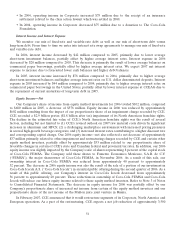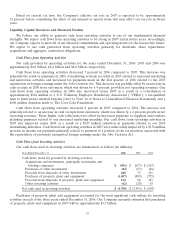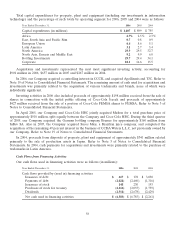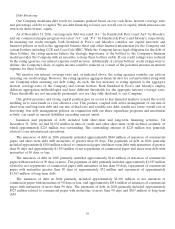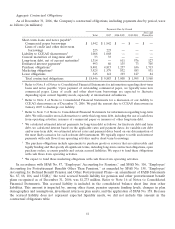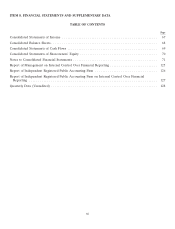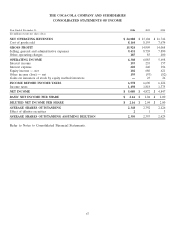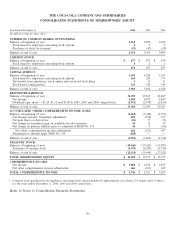Coca Cola 2006 Annual Report Download - page 65
Download and view the complete annual report
Please find page 65 of the 2006 Coca Cola annual report below. You can navigate through the pages in the report by either clicking on the pages listed below, or by using the keyword search tool below to find specific information within the annual report.
currencies in which the Company conducted operations (all operating currencies), and for certain individual
currencies, strengthened (weakened) against the U.S. dollar as follows:
Year Ended December 31, 2006 2005 2004
All operating currencies (1)% 2% 6%
Brazilian real 10 % 21 % 5 %
Mexican peso 0% 4 % (5)%
Australian dollar (1)% 3 % 13 %
South African rand (7)% 1 % 18 %
British pound 1% 0 % 12 %
Euro 1% 1% 9%
Japanese yen (6)% (1)% 7 %
These percentages do not include the effects of our hedging activities and, therefore, do not reflect the
actual impact of fluctuations in exchange rates on our operating results. Our foreign currency management
program is designed to mitigate, over time, a portion of the impact of exchange rate changes on our net income
and earnings per share. The total currency impact on operating income, including the effect of our hedging
activities, was a decrease of approximately 1 percent in 2006. The impact of a weaker U.S. dollar increased our
operating income by approximately 4 percent and 8 percent in 2005 and 2004, respectively. The Company
currently expects currencies to have little impact on operating income in 2007.
Exchange losses—net amounted to approximately $15 million in 2006, $23 million in 2005 and $39 million
in 2004 and were recorded in other income (loss)—net in our consolidated statements of income. Exchange
losses—net include the remeasurement of monetary assets and liabilities from certain currencies into functional
currencies and the costs of hedging certain exposures of our consolidated balance sheets. Refer to Note 12 of
Notes to Consolidated Financial Statements.
The Company will continue to manage its foreign currency exposure to mitigate, over time, a portion of the
impact of exchange rate changes on net income and earnings per share.
Overview of Financial Position
Our consolidated balance sheet as of December 31, 2006, compared to our consolidated balance sheet as of
December 31, 2005, was impacted by the following:
• increases in trademarks with indefinite lives, goodwill and other intangible assets of $99 million,
$356 million and $859 million, respectively, primarily due to our acquisitions of CCCIL, Apollinaris and
TJC as well as the consolidation of Brucephil in 2006;
• an increase in property, plant and equipment of $1,727 million, primarily due to 2006 purchases and
acquisitions and consolidation under Interpretation No. 46(R), as discussed above; and
• a decrease in loans and notes payable of $1,283 million, primarily due to the net repayment of
commercial paper and short-term debt during 2006.
Impact of Inflation and Changing Prices
Inflation affects the way we operate in many markets around the world. In general, we believe that, over
time, we are able to increase prices to counteract the majority of the inflationary effects of increasing costs and
to generate sufficient cash flows to maintain our productive capability.
63



